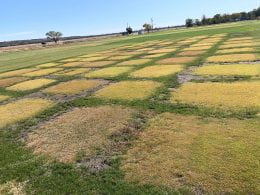By: Manoj Chhetri
With temperatures cooling down and days being shorter, we are already starting to see warm-season grasses, including zoysiagrass, going to sleep. At the Rocky Ford Turfgrass Research Center, located in Manhattan, KS, we have shut down the irrigation in warm-season plots.
Our zoysiagrass in the large-patch tolerant breeding plot is not cooperating with us as much as we wanted. We inoculated the field in mid-September with fresh Rhizoctonia pathogen and kept the field pretty wet to encourage fungi to flourish. However, to our dismay, we did not see much of the disease activity, except in a few poor drainage spots. With disease research, it is the type of research where we want disease pathogens to have no mercy on us. We are impatiently waiting for spring, which in fact is a more favorable time of the year for large patch activity.
We are hopeful that we have at least one or two new zoysiagrass progeny that possess greater large patch tolerance. Again, it is hard to make comparison and evaluate when we don’t have disease pressure. So far, we have narrowed down to 10 best progeny out of 60. On the positive note, we have seen more disease pressure on our non-selected progeny than in our top-ten selected progeny. This tells us that we did a good job on choosing those ten-best progeny.
This project is aiming to develop a large patch tolerant zoysiagrass that can significantly reduce cost on fungicides and protect the environment. It is a collaborative project between Texas A & M and K-State University.

Pictured Above: Zoysiagrass progeny evaluated in large patch disease environment.

Pictured Above: One of the zoysiagrass progeny showing large patch in one inoculated half (right side) and fungicide treated cleaner side on other half (left side).
